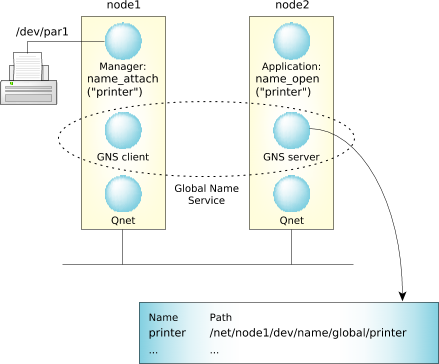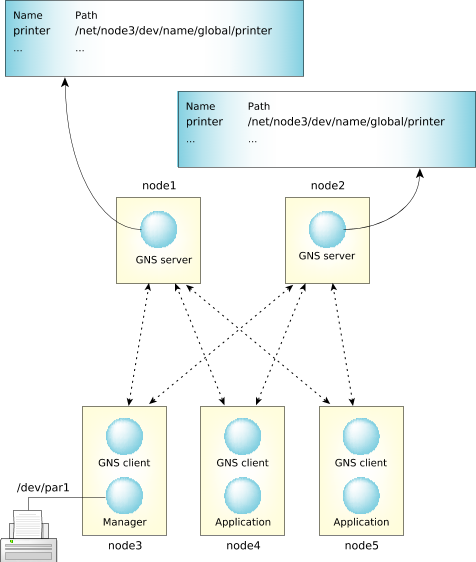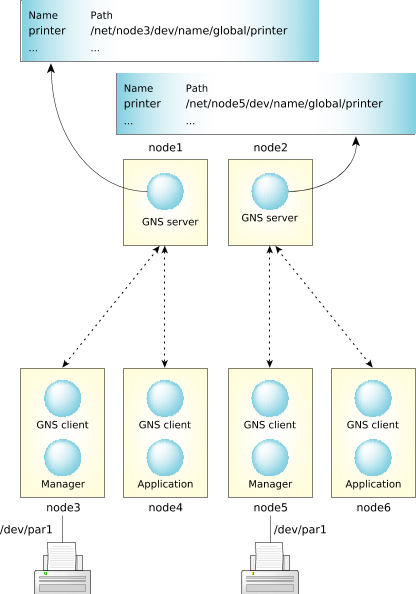You use gns, the Global Name Service or GNS manager to locate services. GNS is a standalone resource manager. With the help of this utility, an application can advertise, look up, and use (connect to) a service across Qnet network, without knowing the details of where the service is, or who the provider is.
Server and client modes
The gns utility runs in two different modes: server and client. A server-mode manager is a central database that stores advertised services, and handles lookup and connect requests. A client-mode manager relays advertisement, lookup, and connect requests between local application and the GNS server(s). For more information on starting and configuring GNS, see the gns utility in the Utilities Reference.
Here's a simple layout for a GNS client and a GNS server distributed over a network:
 Figure 1. A simple GNS setup.
Figure 1. A simple GNS setup.In this example, there's one gns client and one gns server. As far as an application is concerned, the GNS service is one entity. The client-server relationship is only between gns processes (we'll examine this later). The server GNS process keeps track of the globally registered services, while the client GNS process on the other node relays gns requests for that node to the gns server.
When a client and a server application interact with GNS, they use the following APIs:
Server:
- name_attach()
- Register your service with the GNS server.
- name_detach()
- Deregister your service with the GNS server.
Client:
- name_open()
- Open a service via the GNS server.
- name_close()
- Close the service opened with name_open().
Registering a service
In order to use GNS, you need to first register the manager process with GNS, by calling name_attach().
When you register a service, you need to decide whether to register this manager's service locally or globally. If you register your service locally, only the local node is able to see this service; another node is not able to see it. This allows you to have client applications that look for service names rather than pathnames on the node it is executing on. This section highlights registering services globally.
When you register GNS service globally, any node on the network running a client application can use this service, provided the node is running a gns client process and is connected to the gns server, along with client applications on the nodes running the gns server process. You can use a typical name_attach() call as follows:
if ((attach = name_attach(NULL, "printer", NAME_FLAG_ATTACH_GLOBAL)) == NULL) {
return EXIT_FAILURE;
}
The first thing you do is to pass the flag NAME_FLAG_ATTACH_GLOBAL. This causes your service to be registered globally instead locally.
The last thing to note is the name. This is the name that clients search for. This name can have a single level, as above, or it can be nested, such as printer/ps. The call looks like this:
if ((attach = name_attach(NULL, "printer/ps", NAME_FLAG_ATTACH_GLOBAL)) == NULL) {
return EXIT_FAILURE;
}
Nested names have no impact on how the service works. The only difference is how the services are organized in the filesystem generated by gns. For example:
$ ls -l /dev/name/global/ total 2 dr-xr-xr-x 0 root techies 1 Feb 06 16:20 net dr-xr-xr-x 0 root techies 1 Feb 06 16:21 printer $ ls -l /dev/name/global/printer total 1 dr-xr-xr-x 0 root techies 1 Feb 06 16:21 ps
The first argument to the name_attach() function is the dispatch handle. You pass a dispatch handle to name_attach() once you've already created a dispatch structure. If this argument is NULL, a dispatch structure is created automatically.
What happens if more than one instance of the server application (or two or more applications that register the same service name) are started and registered with GNS? This is treated as a redundant service. If one application terminates or detaches its service, the other service takes over. If the server is local to the client, that server is tried; if this isn't possible, there's no guaranteed ordering.
There's no credential restriction for applications that are attached as local services. An application can attach a service globally only if the application has root privilege.
When you no longer wish to provide serice via GNS, you should call name_detach(). This removes the service from GNS.
For more information, see name_attach() and name_detach() in the C Library Reference.
Locating a service
Your client should call name_open() to locate the service. If you wish to locate a global service, you need to pass the flag NAME_FLAG_ATTACH_GLOBAL:
if ((coid = name_open("printer", NAME_FLAG_ATTACH_GLOBAL)) == -1)
{
return EXIT_FAILURE;
}
or:
if ((coid = name_open("printer/ps", NAME_FLAG_ATTACH_GLOBAL)) == -1)
{
return EXIT_FAILURE;
}
If you don't specify this flag, GNS looks only for a local service. The function returns a side-channel connection (coid) that you can use to access the service manager by sending messages, just as if you had located a local service.
GNS pathname space
A service is represented by a pathname (without a leading “/”) and is registered under /dev/name/global or /dev/name/local, depending on how it attaches itself. Every machine running a gns client or server on the same network has the same view of the /dev/name/global pathname space. Each machine has its own local pathname space /dev/name/local that reflects its own local services.
Here's an example after a service called printer has attached itself globally:
$ ls -l /dev/name/global/ total 2 dr-xr-xr-x 0 root techies 1 Feb 06 16:20 net dr-xr-xr-x 0 root techies 1 Feb 06 16:21 printer
Deploying the gns processes
When you deploy the gns processes on your network, you start the gns process in two modes: server and client. You need at least one gns process running as a server on one node, and you can have one or more gns clients running on the remaining nodes. The role of the gns server process is to maintain the database that stores the advertised services. The role of a client gns process is to relay requests from its node to the gns server process on the other node. A gns process must be running on each node that wishes to access GNS.
It's possible to start multiple global name service managers (gns process) in server mode on different nodes. You can deploy server-mode gns processes in two ways: as redundant servers, or as servers that handle two or more different global domains.
In the first scenario, you have two or more servers with identical database information. The gns client processes are started with contact information for both servers. Operations are then sent to all gns server processes. The gns servers, however, don't communicate with each other. This means that if an application on one gns server node wants to register a global service, another gns server can't do it. This doesn't affect other applications on the network, because when they connect to that service, both GNS servers are contacted.
 Figure 2. A redundant GNS setup.
Figure 2. A redundant GNS setup.You don't have to start all redundant gns servers at the same time. You can start one gns server process first, and then start a second gns server process at a later time. In this case, use the special option -s backup_server on the second gns server process to make it download the current service database from another node that's already running the gns server process. When you do this, the clients connected to the first node (that's already running the gns server process) are notified of the existence of the other server.
In the second scenario, you maintain more than one global domain. For example, assume you have two nodes, each running a gns server process. You also have a client node that's running a gns client process and is connecting to one of the servers. A different client node connects to the other server. Each server node has unique services registered by each client. A client connected to server node1 can't see the service registered on the server node2.
 Figure 3. Separate global domains.
Figure 3. Separate global domains.What is demonstrated in each scenario is that it's the client that determines whether a server is acting as a redundant server or not. If a client is configured to connect to two or more servers, then those servers are redundant servers for that client's services. The client can see the services that exist on those servers, and it registers its services with those servers.
There's no limit to the number of server mode gns processes that can be run on the network. Increasing the number of servers, however, in a redundant environment can increase network use and make gns function calls such as name_attach() more expensive as clients send requests to each server that exists in its configuration. It's recommended that you run only as many gns servers in a redundant configuration as your system design requires and no more than that.
For more information, see gns documentation in the Utilities Reference.